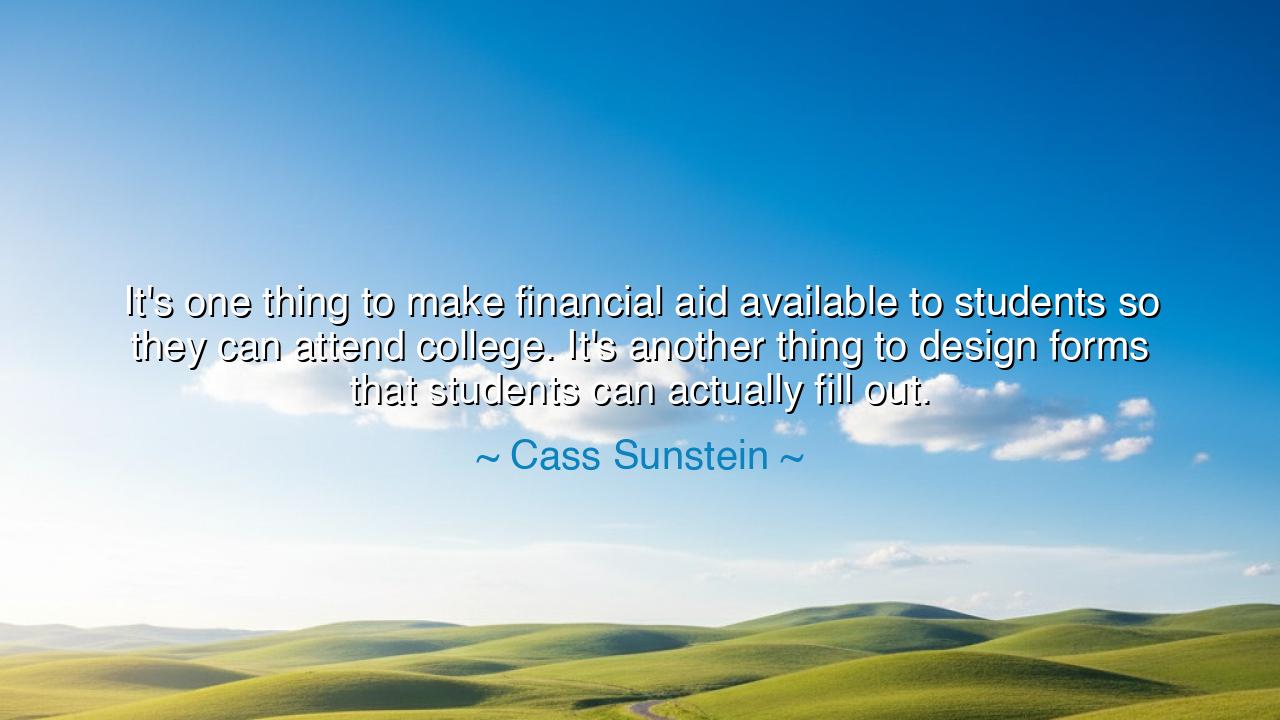
It's one thing to make financial aid available to students so
It's one thing to make financial aid available to students so they can attend college. It's another thing to design forms that students can actually fill out.






“It’s one thing to make financial aid available to students so they can attend college. It’s another thing to design forms that students can actually fill out.” – Cass Sunstein
In these words, Cass Sunstein, the philosopher of policy and human behavior, speaks with the wisdom of a man who understands that intention without accessibility is illusion. He reminds us that it is not enough to create systems of good will if those systems are too complex for the people they are meant to serve. A bridge built for the poor is no gift if it cannot be crossed; a door opened in name only is still a wall. Thus, in his simple yet profound statement, Sunstein exposes one of the quiet failures of modern governance and design: the tendency to forget the human in the pursuit of the ideal.
The origin of this quote lies in Sunstein’s lifelong study of behavioral economics and public policy, particularly his collaboration with Nobel laureate Richard Thaler in the groundbreaking work Nudge: Improving Decisions About Health, Wealth, and Happiness. There, Sunstein explored how systems — even those created with good intentions — often fail because they do not account for how real people think, feel, and act. Bureaucracies love rules, but human beings live by intuition. Governments may design policies to help, but if those policies are tangled in confusion, they become obstacles rather than opportunities. The financial aid form, then, becomes a metaphor — a symbol of every structure that means well yet alienates through complexity.
Sunstein’s insight reaches far beyond education. In every society, there are countless examples of aid and programs that exist in theory but fail in practice. Consider the Affordable Care Act’s early website rollout — an initiative meant to extend healthcare to millions, yet paralyzed at its birth by poor design. The system’s architects envisioned accessibility for all, but forgot that accessibility is not just about availability — it is about usability. The tools meant to liberate often become labyrinths when the designers forget the hands that will hold them and the minds that must navigate them.
This lesson is not new. Even in ancient times, leaders understood that law and policy must serve the people in spirit, not merely in word. The philosopher-king Marcus Aurelius once wrote that justice is hollow when it is unintelligible to the governed. The same truth echoes in Sunstein’s reflection: true justice is not in the policy’s promise, but in its practicality. To make aid available is to plant the seed; to make it usable is to tend the soil so that it may grow. Without that second act of care, the seed withers in the earth — potential unrealized, mercy undone.
But beneath this critique lies hope — for Sunstein is not lamenting human failure, but calling for a new kind of wisdom in design. He urges us to think not as engineers of systems, but as servants of humanity. To design forms that “students can actually fill out” means to walk in their shoes, to see through their eyes, to simplify not for convenience but for compassion. The human-centered approach, as it is now called, is not a soft art — it is the foundation of enduring success. For systems that ignore human nature crumble, while those that honor it endure.
Think of the reforms brought by Franklin D. Roosevelt during the Great Depression. The New Deal was not perfect, but it worked because it met people where they were. Its programs were not buried in jargon or distant in reach; they were tangible, clear, and human. Workers could understand them, access them, and benefit from them. This is what Sunstein calls us back to: the art of designing for people, not around them. For the highest wisdom in any age is not to build grand structures, but to build structures that serve.
The lesson, then, is both practical and moral. When you create — whether it be a form, a policy, a product, or even a relationship — ask not only, “Is it good?” but “Is it usable? Is it human?” Goodness locked behind confusion is no goodness at all. The world does not need more lofty ideas; it needs more clear paths. And those who design such paths perform a quiet revolution, restoring dignity to the ordinary and power to the overlooked.
So, dear listener, let this truth guide your craft and your conscience: the nobility of design lies not in its complexity, but in its clarity. Create as Sunstein teaches — from empathy, not ego; from understanding, not assumption. For when we shape systems, forms, or even words that all can navigate, we do not merely simplify life — we restore justice. And that, above all, is the most human act of design there is.






AAdministratorAdministrator
Welcome, honored guests. Please leave a comment, we will respond soon